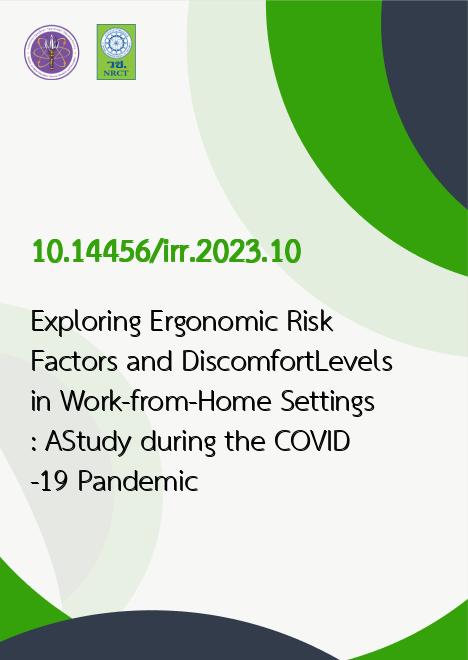
|
Exploring Ergonomic Risk Factors and DiscomfortLevels in Work-from-Home Settings: AStudy during the COVID-19 Pandemic |
|---|---|
| รหัสดีโอไอ | |
| Creator | Worrawit Nakpan |
| Title | Exploring Ergonomic Risk Factors and DiscomfortLevels in Work-from-Home Settings: AStudy during the COVID-19 Pandemic |
| Contributor | Pathanin Sangaroon, Anunya Pradidthaprecha, KultidaBunjongsiri, Araya Prasertchai, Pokkamol Laoraksawong, Saruda Jiratkulthana |
| Publisher | Phetchaburi Rajabhat University |
| Publication Year | 2566 |
| Journal Title | Interdisciplinary Research Review (IRR) |
| Journal Vol. | 18 |
| Journal No. | 5 |
| Page no. | 22-28 |
| Keyword | COVID-19, Work from home, Ergonomics, Workstation, Discomfort |
| URL Website | https://ph02.tci-thaijo.org/index.php/jtir |
| Website title | Interdisciplinary Research Review (IRR) |
| ISSN | 2697-536X |
| Abstract | This study examines the impact of working from home on the ergonomic risk factors and discomfort experienced by workersduring the COVID-19 pandemic. Despite the many benefits of working from home, such as increased productivity and flexibleworking hours, it also presents numerous ergonomic threats, including suboptimal working postures, poor workstation design,uncontrolled working hours, and poor indoor environmental quality. The study aims to identify the risk factors for discomfortamong workers who work from home during the COVID-19 pandemic by using an ergonomic assessment tool. The study usedan anonymous online questionnaire in Thai, posted on social media platforms, and had a sample size of 303 Thai participantsaged 20 years and above, working from home, and using computer for work. Data were obtained through a three-sectionquestionnaire that collected demographic information, workstation assessment, and discomfort scale. The results showed thatthere is a significant relationship between ergonomic factors and discomfort in the neck, lower back, and legs such as chair,workstation, and breaks. The study concludes that ergonomic assessment tools are essential in identifying potential ergonomicrisks and improving the health and safety of workers. Such tools can be tailored to specific industries, job types, or workenvironments, making them more useful and applicable for different workplaces. This study’s findings will help occupationalhealth professionals and policymakers develop and implement effective ergonomic interventions to mitigate ergonomic risksand prevent work-related musculoskeletal disorders (MSDs) among workers who work from home during the pandemic. |